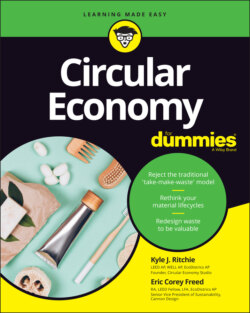Читать книгу Circular Economy For Dummies - Eric Corey Freed - Страница 58
NADINE GUDZ SPEAKS
ОглавлениеNadine Gudz is an award-winning sustainability leader and the former global director of Sustainability Strategy at Interface, one of the world’s leading modular flooring companies. They also happen to produce some of the most sustainable carpeting available. Its initial founder and chairman, Ray C. Anderson, transformed his company in 1994 after reading The Ecology of Commerce by Paul Hawken and committed his company to eliminating “any negative impact the company may have on the environment by the year 2020.”
This daunting challenge was referred to as “Mission Zero” inside of the company, and they called their efforts “climbing Mount Sustainability.” The authors sat down with Nadine to discuss the challenges of taking a resource-intensive product like carpet and transform it into a circular product.
Carpet is a massive, material intensive resource. Raw materials are inserted into one end of a machine and carpet comes out the other. Despite its popularity, carpet also has a huge environmental cost, where after only 5 or 7 years it gets thrown into the landfill and replaced. So it makes sense that a carpet company like Interface would pioneer how to improve on this.
Nadine Gudz: There are so many learning opportunities to think differently throughout a carpet’s supply chain — purchasing, installation, maintenance, how you interact in that relationship. Context is really important.
It was very exciting to be a part of a manufacturer that was open to trying different things. For example, the launch of Interface’s Embodied Beauty, the first carpet tile to absorb the carbon it takes to produce it.
What's become clear to you as you've tried to implement the idea of “carpeting as a service?” On the one hand, it seems like a simple thing to tell customers that you’ll provide the benefits that carpet provides, but without having to own it. But on the other, I know it’s much more complicated than that.
Nadine Gudz: It really is. When Ray [Anderson, CEO of Interface] first talked about the idea of the evergreen carpet leasing program, it generated so much interest. The program was piloted with one friendly customer who was willing to try it out. It didn't go anywhere. It was impossible to sell this idea of leasing or renting carpet. It just didn't fit with our customer’s traditional mindsets around budgets.
There continues to be a lot of interest in this from customers and passion for it at Interface. And now with the momentum around circular economy, I think the conditions might be right to bring it back.
Interface pioneered how to green their sourcing and supply chain. Why were you so successful with that? In what Interface refers to as “climbing Mount Sustainability,” how did you take on the challenge of changing your supply chain, knowing that it would be hard?
Nadine Gudz: It was so hard, but the timeframe really matters here. The company’s sustainability awakening occurred in 1994. It didn't take long to get a team on board to help advise Interface and create this roadmap to Mt. Sustainability, setting a bold, audacious goal we call “Mission Zero” — to eliminate any negative environmental impact by the year 2020.
The big shift, which was a very difficult decision-making process, had to do with letting go of suppliers who were not willing to invest in the technologies to recycle nylon [the chief ingredient in carpeting]. The key fibers used in Interface products were more sustainable, and in order to get to zero carbon, Interface could not be using virgin nylon in its products.
The company quickly realized that using recycled nylon would dramatically reduce the company’s carbon footprint. It took 13 years for Interface to actually procure recycled nylon from suppliers who were both willing and technologically able to make these recycled yarns.
Today Interface uses hundreds of color palettes with a majority of recycled nylon (a huge jump from 1994 to 2007!) It took 13 years to address the main culprit in the supply chain, and its thanks to two primary suppliers who were willing to step up, invest, and see the potential and the opportunity. See how the market has shifted?
How did they source the recycled nylon?
Nadine Gudz: It’s an amazing global partnership, starting with fishing communities in the Philippines and a very progressive supplier, Aquafil.
Their CEO, Giulio Bonazzi, was inspired by Ray and Interface’s story. Their team found a way to make nylon fibers from discarded fishing nets. That inspired our innovation team to ask the question: “Where would fishing net recycling do the most good in the world?” In conversations with biologists at the Zoological Society of London, the answer was: the Philippines.
That’s what started our Networks program, and it has now expanded to Indonesia and Cameroon. It's a self-sufficient, stand-alone program supporting local economic stability along with sustainability efforts.
Residents are paid fair market value for the nets that are being collected from the ocean and the shorelines. They run community banking associations where they get access to micro-finance solutions that didn't exist before.
It links so beautifully with some of these themes around circular economy and social well-being, in addition to the obvious environmental benefits of these kinds of partnerships.
In hindsight, it seems as if Interface knew this would be a challenge. You didn't call it “downhill sustainability.” You called it “Mt. Sustainability,” implying that it would be a labor of love, and it was going to take time.
Nadine Gudz: You're totally right. You need to wrap your head around the fact that these sorts of changes don't happen overnight. It requires big commitment. It requires conviction. It requires a flexibility and adaptability.
From an organizational cultural perspective, Interface gave its employees permission to pursue these ideas and these partners. It wasn't Interface who was recycling the fishing nets; it was this very inspired, innovative supplier. That’s what creates this life-changing innovation and ripple effect.
